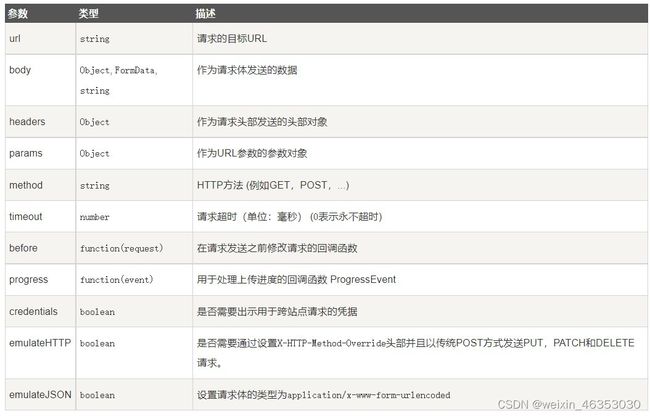一、使用Vue.http/this.$http
在发起请求的时候,为了减少作用域链的搜索,建议使用一个局部变量来接受this
1. GET请求
// 基于全局Vue对象使用http
Vue.http.get('/someUrl', [options]).then(successCallback, errorCallback);
// 在一个Vue实例内使用$http
this.$http.get('/someUrl', [options]).then(successCallback, errorCallback);
示例
//不带参数的get请求
this.$http.get('/someUrl').then(function(res){
console.log('请求成功处理');
},function(res){
console.log('请求失败处理');
});
//需要传递数据的get请求
this.$http.get('/someUrl',{param:jsonData}).then(function(res){
console.log('请求成功处理');
},function(res){
console.log('请求失败处理');
});
//ES6的Lambda写法
this.$http.get('/someUrl', [options]).then((response) => {
console.log('请求成功处理');
}, (response) => {
console.log('请求失败处理');
});
2.POST请求
post 发送数据到后端,需要第三个参数 {emulateJSON:true}。
emulateJSON 的作用: 如果Web服务器无法处理编码为 application/json 的请求,你可以启用 emulateJSON 选项。启用该选项后,请求会以application/x-www-form-urlencoded作为MIME type,就像普通的HTML表单一样。
// 基于全局Vue对象使用http
Vue.http.post('/someUrl', [body], [options]).then(successCallback, errorCallback);
// 在一个Vue实例内使用$http
this.$http.post('/someUrl', [body], [options]).then(successCallback, errorCallback);
示例
this.$http.post('/try/ajax/demo_test_post.php',{name:"菜鸟教程",url:"http://www.runoob.com"},{emulateJSON:true}).then(function(res){
document.write(res.body);
},function(res){
console.log(res.status);
});
二、使用Vue.resource/this.$resource
vue-resource提供了另外一种方式访问HTTP——resource服务,resource服务包含以下几种默认的action:
get: {method: 'GET'},
save: {method: 'POST'},
query: {method: 'GET'},
update: {method: 'PUT'},
remove: {method: 'DELETE'},
delete: {method: 'DELETE'}
访问resource对象的两种方式:
//全局访问 Vue.resource //实例访问 this.$resource
GET请求
//使用一个局部变量来接受this
var vm = this;
this.$resource('apiUrl').get().then((response) => {
console.log("调用成功");
})
.catch(function(response) {
console.log("调用失败");
})
}
POST请求
使用save方法发送POST请求
//使用一个局部变量来接受this
var vm = this;
this.$resource('apiUrl').save('apiUrl',Target).then((response) => {
console.log("调用成功");
})
.catch(function(response) {
console.log("调用失败");
})
}
inteceptor – 在请求前和请求后附加行为
拦截器可以在请求发送前和发送请求后做一些处理
用法
//Lambda函数写法
Vue.http.interceptors.push((request, next) => {
// ...
// 请求发送前的处理逻辑
// ...
next((response) => {
// ...
// 请求发送后的处理逻辑
// ...
// 根据请求的状态,response参数会返回给successCallback或errorCallback
return response
})
})
//普通写法
Vue.http.interceptors.push(function(request, next) {
// ...
// 请求发送前的处理逻辑
// ...
next(function(response) {
// ...
// 请求发送后的处理逻辑
// ...
// 根据请求的状态,response参数会返回给successCallback或errorCallback
return response
})
})
实例 – 为所有的请求处理加一个loading
请求发送前显示loading,接收响应后隐藏loading或显示指定的loading信息;
添加loading.vue组件
在父组件中引入loading组件
//loading 发起请求时显示//modal-dialog 请求失败时显示 Server Error
Oops,server has got some errors, error code: {{errorCode}}.
在父组件中添加inteceptor
data: {
showLoading: false,
showDialog: false,
errorCode: ''
},
//在生命周期中添加inteceptor
Vue.http.interceptors.push((request, next) => {
help.showLoading = true
next((response) => {
if(!response.ok){
help.errorCode = response.status
help.showDialog = true
}
help.showLoading = false
return response
});
});
拓展
vue-resource 提供了 7 种请求 API(REST 风格):
get(url, [options]) head(url, [options]) delete(url, [options]) jsonp(url, [options]) post(url, [body], [options]) put(url, [body], [options]) patch(url, [body], [options])
除了 jsonp 以外,另外 6 种的 API 名称是标准的 HTTP 方法。其中,options参数说明如下:
可以通过如下属性和方法处理一个请求获取到的响应对象:
参考文章
菜鸟教程
完整代码示例及其他请求方法的使用
代码是参考上面两篇文章写出来的,没有实际运行过;且只记录了GET/POST两种请求方式,其它请求方式以及完整代码需要参考第二篇文章
到此这篇关于vue处理get/post的http请求的实例的文章就介绍到这了,更多相关vue get/post的http请求内容请搜索脚本之家以前的文章或继续浏览下面的相关文章希望大家以后多多支持脚本之家!


